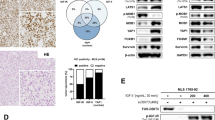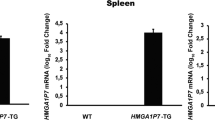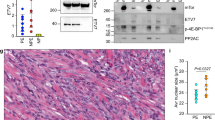Abstract
The characteristic t(12;16)(q13;p11) chromosomal translocation, which leads to gene fusion that encodes the FUS-CHOP chimeric protein, is associated with human liposarcomas. The altered expression of FUS-CHOP has been implicated in a characteristic subgroup of human liposarcomas. We have introduced the FUS-CHOP transgene into the mouse genome in which the expression of the transgene is successfully driven by the elongation factor 1α (EF1α) promoter to all tissues. The consequent overexpression of FUS-CHOP results in most of the symptoms of human liposarcomas, including the presence of lipoblasts with round nuclei, accumulation of intracellular lipid, induction of adipocyte-specific genes and a concordant block in the differentiation program. We have demonstrated that liposarcomas in the FUS-CHOP transgenic mice express high levels of the adipocyte regulatory protein PPARγ, whereas it is not expressed in embryonic fibroblasts from these animals following induction to differentiation toward the adipocyte lineage, indicating that the in vitro system does not really reflect the in vivo situation and the developmental defect is downstream of PPARγ expression. No tumors of other tissues were found in these transgenic mice despite widespread activity of the EF1α promoter. This establishes FUS-CHOP overexpression as a key determinant of human liposarcomas and provide the first in vivo evidence for a link between a fusion gene created by a chromosomal translocation and a solid tumor.
This is a preview of subscription content, access via your institution
Access options
Subscribe to this journal
Receive 50 print issues and online access
$259.00 per year
only $5.18 per issue
Buy this article
- Purchase on SpringerLink
- Instant access to full article PDF
Prices may be subject to local taxes which are calculated during checkout







Similar content being viewed by others
References
Adams JM, Harris AW, Pinkert CA, Corcoran LM, Alexander WS, Cory S, Palmiter RD and Brinster RL . 1985 Nature 318: 533–538
Adelmant G, Gilbert JD and Freytag SO . 1998 J Biol Chem 273: 15574–15581
Ailhaud G, Grimaldi P and Negrel R . 1992 Annu Rev Nutr 12: 207–233
Altabef M, Garcia M, Lavau C, Bae S-C, Dejean A and Samarut J . 1996 EMBO J 15: 2707–2716
Aman P, Panagopoulos I, Lassen C, Fioretos T, Mencinger M, Toresson H, Hoglund M, Forster A, Rabbitts TH, Ron D, Mandahl N and Mitelman F . 1996 Genomics 37: 1–8
Batchvarova N, Wang XZ and Ron D . 1995 EMBO J 14: 4654–4661
Benneth JH, Shousha S, Puddle B and Athanasou NA . 1995 J Clin Pathol 48: 950–954
Cao Z, Umek RM and McKnight SL . 1991 Genes Dev 5: 1538–1552
Carlson SG, Fawcett TW, Bartlett JD, Bernier M and Holbrook NJ . 1993 Mol Cell Biol 13: 4736–4744
Castellanos A, Pintado B, Wuruaga E, Arévalo R, López A, Orfao A and Sánchez-García I . 1997 Blood 90: 2168–2174
Chang HR, Hajdu SI, Collin C and Brennan MP . 1989 Cancer 64: 1514–1520
Crozat A, Aman P, Mandahl N and Ron D . 1993 Nature 363: 640–644
Fornace Jr AJ, Nebert DW, Hollander MC, Luethy JD, Papathanasiou M, Fargnoli J and Holbrook N-J . 1989 Mol Cell Biol 9: 4196–4203
Freytag SO and Geddes TJ . 1992 Science 256: 379–382
Hwang C-S, Loftus TM, Mandrup S and Lane MD . 1997 Annu Rev Cell Dev Biol 13: 231–259
Ichikawa H, Shimizu K, Hayashi Y and Ohki M . 1994 Cancer Res 54: 2865–2868
Kliewer SA, Umesono K, Noonan DJ, Heyman RA and Evans RM . 1992 Nature 358: 771–774
Knight JC, Renwick PJ, Cin PD, Van den Berghe H and Fletcher CD . 1995 Cancer Res 55: 24–27
Kuroda M, Ishida T, Takanashi M, Satoh M, Machinami R and Watanabe T . 1997 Am J Pathol 151: 735–744
Leder A, Pattengale PK, Kuo A, Stewart TA and Leder P . 1986 Cell 45: 485–495
Mack TM . 1995 Cancer 75: 211–244
Mizushima S and Nagata S . 1990 Nucleic Acid Research 18: 4322
Panagopoulos I, Aman P, Fioretos T, Höghind M, Johansson B, Mandahl N, Heim S, Behrendtz M and Mitelman F . 1994 Genes Chrom Cancer 11: 256–262
Panagopoulos I, Mandahl N, Mitelman F and Aman P . 1995 Oncogene 11: 1133–1137
Prasad DD, Ouchida M, Lee L, Rao VN and Peddy ESP . 1994 Oncogene 9: 3717–3729
Price BD and Calderwood SK . 1992 Cancer Res 52: 3814–3817
Quiafe CJ, Pinkert CA, Ornitz DM, Palmiter RD and Brinster R . 1987 Cell 48: 1023–1034
Rabbitts TH, Forster A, Larson R and Nathan P . 1993 Nature Genet 4: 175–180
Rabbitts TH . 1994 Nature 372: 143–149
Ron D and Habener JF . 1992 Genes Dev 6: 439–453
Ruther U, Garbner C, Komitowski D, Muller R and Wagner EF . 1987 Nature 325: 412–416
Samuelsson L, Stromberg K, Vikman K, Bjursell G and Enerback S . 1991 EMBO J 10: 3787–3793
Sánchez-García I and Rabbitts TH . 1994 Proc Natl Acad Sci USA 91: 7869–7873
Sánchez-García I . 1997 Annu Rev Genetics 31: 429–453
Shimizu K, Ichikawa H, Tojo A, Kaneko Y, Maseki N et al. 1993 Proc Natl Acad Sci USA 90: 10280–10284
Sinn E, Muller W, Pattengale P, Tepler I, Wallace R and Leder P . 1987 Cell 49: 465–475
Takada T, Iida K, Awaji T, Itoh K, Takahashi R, Shibui A, Yoshida K, Sugano S and Tsujimoto G . 1997 Nature Biotech 15: 458–461
Tanaka T, Yoshida N, Kishimoto T and Akira S . 1997 EMBO J 16: 7432–7443
Tontonoz P, Singer S, Forman BM, Sarraf P, Fletcher JA, Fletcher CDM, Brun RP, Mueller E, Altiok S, Oppenheim H, Evans RM and Spiegelman BM . 1997 Proc Natl Acad Sci USA 94: 237–241
Umek RM, Friedman AD and McKnight SL . 1991 Science 251: 288–292
Wang ND, Finegold MJ, Bradley A, Ou CN, Abdelsayed SV, Wilde MD, Taylor LR and Wilson DR . 1995 Science 269: 1108–1112
Wang XZ, Lawson B, Brewer JW, Zinszner H, Sanjay A, Mi LJ, Boorstein R, Kreibich G, Hendershot LM and Ron D . 1996 Mol Cell Biol 16: 4273–4280
Yeh WC, Cao Z, Classon M and McKnight SL . 1995 Genes Dev 9: 168–181
Zinszner H, Albalat R and Ron D . 1994 Genes Dev 8: 2513–2526
Acknowledgements
We are grateful to Dr R Arévalo for providing the histological facilities. We are indebted to Dr C Cobaleda for help in the preparation of the manuscript, and specific thanks to JC Villoria-Terrón and JF Martín-Martín for excellent technical advice. This work has been supported by European Commission (BMH4-CT96-0375), DGCYT (UE96-0041, PB96-0816 and 1FD97-0360), Fundación Científica of the AECC, FIS (99/0935) and NIH grant (1 R01 CA79955-01).
Author information
Authors and Affiliations
Rights and permissions
About this article
Cite this article
Pérez-Losada, J., Pintado, B., Gutiérrez-Adán, A. et al. The chimeric FUS/TLS-CHOP fusion protein specifically induces liposarcomas in transgenic mice. Oncogene 19, 2413–2422 (2000). https://doi.org/10.1038/sj.onc.1203572
Received:
Revised:
Accepted:
Published:
Issue Date:
DOI: https://doi.org/10.1038/sj.onc.1203572



